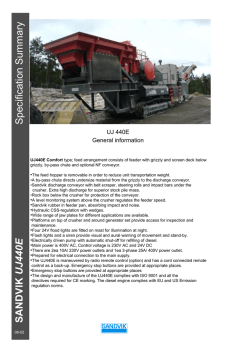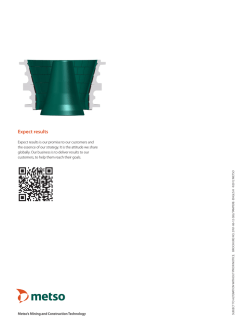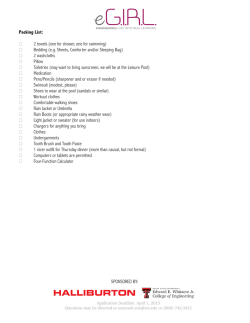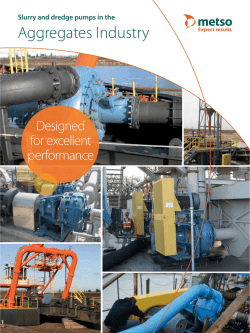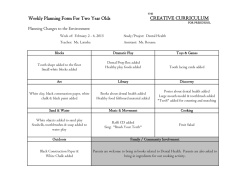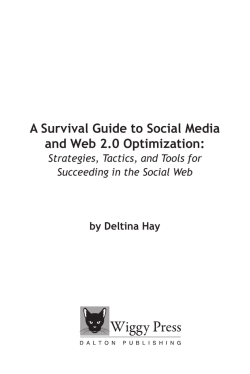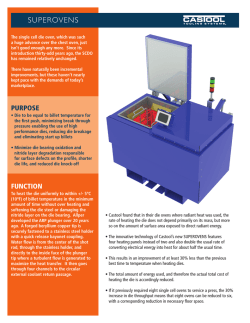
Nordberg C series jaw crushers
Nordberg C series jaw crushers Wear parts application guide Wear parts application guide - Nordberg C series jaw crusher C jaw crusher and basic concepts The jaw crusher is a compression type crusher. Feed material is crushed between fixed and movable jaw dies. Large particles are crushed in a single layer, referred to as single-layer crushing. Smaller particles are crushed rock on rock, referred to as multi-layer crushing. Feed opening Feed opening (depth of the cavity) defines the maximum feed size of the crusher. In the C jaw crusher, the feed opening is measured from the top of the tooth of the fixed jaw to the bottom of the tooth of the movable jaw in a straight line perpendicular to the center line of the crushing cavity. The maximum feed size is approximately 80% of the feed opening. C80 C100 C96 C106 C116 C3054 C110 C120 C125 C140 C145 C160 C200 2 Feed opening depth mm in 510 760 600 700 800 760 850 870 950 1070 1100 1200 1500 20 30 24 28 32 30 34 35 37 42 43 47 59 Cavity width mm in 800 1000 930 1060 1150 1380 1100 1200 1250 1400 1400 1600 2000 32 40 37 42 45 54 44 48 49 55 55 63 79 Open side setting (OSS) The open side setting is measured when the crusher is at rest. The setting is measured either top to top, or bottom to top, depending on the tooth profile of the jaw dies. Closed side setting (CSS) The closed side setting can be calculated by deducting the stroke from the OSS. CSS is the most important crusher parameter since it defines the maximum product size and has significant bearing on capacity, product gradation, power draw, and wear. Check the instruction manual for the permitted minimum CSS. Dimensions to be deducted from the OSS mm in C80 C100 C96 C106 C116 C3054 C110 C120 C125 C140 C145 C160 C200 24 32 32 34 37 32 36 37 41 41 41 41 50 1 1 1/4 1 1/4 1 5/16 1 1/2 1 1/4 1 3/8 1 1/2 1 5/8 1 5/8 1 5/8 1 5/8 2 Nip angle The nip angle is the angle between the fixed and movable jaw dies. Too large a nip angle reduces the capacity and increases the wear as the feed material grinds and gouges the jaw dies in an upwards direction during the compressive stroke of the pitman. 3 How to operate a C jaw crusher In order to get optimum capacity and maximum lifetime of wear parts, consider the following points: 1. Check the feed size • Oversize feed material decreases capacity and can cause unnecessary stresses to the crusher components. • Small feed size increases wear at the bottom of the cavity and may cause poor utilization of wear parts. Optimum material level 2. Check the feed arrangement • In order to reach optimum capacity and maximize on the life of the wear parts, the crusher cavity should be full. • The feed must be distributed evenly across the crushing chamber. 4 3. Apply proper scalping • Fines (material smaller then CSS) should be removed from the feed material. This is done by the grizzly bar section of the feeder. Fines in the jaw crusher increase the percentage of contact area against the jaw dies. This increases scratching and grinding and reduces lifetime. 4. Choose the correct jaw dies for the application 5. Check the wear profile of the jaws • An uneven wear profile will decrease capacity, increase wear, and increase crushing forces. Note: Feed material characteristics such as gradation, bulk density, moisture, clay content and crushability have significant impact on crusher capacity. 5 C jaw crusher wear parts Due to the wide range of applications and feed material, many types of jaws are available for the C jaw crushers. Below you will find features and basic recommendations for selecting the wear parts. Super Quarry Superteeth Quarry thick grip XT610 XT710 XT710 XT710 XT810 XT710 XT710 XT810 Standard Blasted rock Difficult and abrasive Difficult and non abrasive ●● Medium and abrasive Medium and non abrasive ●● ● Easy and abrasive ●●● Easy and non abrasive ●● Slabby soft rock Gravel Abrasive ●●● Non abrasive Slippery/ round rock Abrasive ●●● Non abrasive Asphalt recycling ●● Concrete recycling Demolition waste recycling ●● ● Can be used EXISTING PROFILES* 6 ● ●●● ●● ●●● ●● ●●● ●● ●● ●●● ●● ●●● ●● ●●● ●● ●●● ●● ●● ●● ●● ●● Good choice Standard XT610 C63 C80 C100 C96 C105 C106 C116 C3054 C3055 C110 C120 C125 C140 C145 C160 C200 ● ●●● ●● ●●● ●● ●●● ●● ■ ■ ■ ■ ■ XT710 ■ ■ ■ ■ ●●● ●● ●●● ●● ● ●● ●● ●● ●● ●● ●● Super grip XT710 ■ ■ ●●● ●● ●●● ●●● ●●● ●●● ●●● ●● ●●● ●● ● ●●● ●●● ●●● ●● ●● ●● ●● ●●● ●● ●●● ●● ●●● ●●● ●●● Quarry thick + Anti-slab Recycling Wavy like super grip XT710 XT810 XT710 XT610/ 710 XT610/ 710 ●●● ●●● ●●● ●●● ●● ●● ●●● ●● ●●● ●●● ●●● ●●● ●●● ●● ● ● ●● ●● ●●● ●●● ●●● Recommended ■ ■ ●●● ●● ●●● ●●● ●●● ●●● ● Quarry + super grip XT710 XT810 Definitions for different rock types are presented in Wear and materials application guide, page 4. Quarry Superteeth XT710 XT810 XT710 ■ ■ ■ ■ ■ ■ ■ ■ ■ ■ ■ ■ ■ ■ ■ Quarry thick XT710 XT810 Quarry + super grip XT710 XT810 ■ ■ ■ ■ ■ ●●● ■ ■ ■ ■ ■ ■ ■ ■ ■ ■ ■ ■ ■ ■ ■ ■ ■ ■ ■ ■ ■ ■ ■ ■ * More cavities under development, ask for tailored solution options from your local Metso representative. ■ ■ ■ Quarry thick + Anti-slab Recycling Wavy like super grip XT710 XT810 XT710 XT610/ 710 XT610/ 710 ■ ■ ■ ■ ■ ■ ■ ■ ■ ■ ■ ■ ■ ■ ■ ■ ■ ■ ■ ■ ■ ■ ■ ■ ■ Standard (XT710) • Good in gravel and non abrasive rock • Tooth spacing ideal for fines removal • Power requirement and crushing stresses are in balance • Less slabby product • Reduced lifetime in abrasive application Superteeth (XT710) • General use in gravel and blasted rock • Tooth spacing ideal for fines removal • More tooth contact surface area compared to standard profile • More wearable Mn-steel than in standard jaws • Power requirement and crushing stresses are in balance • Less slabby product Quarry thick + Super grip (XT710, XT810) • Good in blasted rock, difficult natural rock and slippery rock • Sharp tooth profile (good grip on the rock) • Power requirement and crushing stresses are in balance • Tooth spacing ideal for fines removal • Can be used when scalping is not efficient • Less slabby product Super grip (XT710) • Good in gravel and non abrasive rock • Tooth spacing ideal for fines removal • Power requirement and crushing stresses are in balance • Less slabby product • Reduced lifetime in abrasive application Quarry (XT710, XT810) • Good in abrasive and/ or blasted rock • Flat tooth profile maximizes lifetime (more surface area to crush with) • More wearable Mn-steel than in standard jaws • Higher stresses and power requirements • Less space for fines to pass through (fines removal from feed material is important) • Increase in slabby product Quarry thick (XT710, XT810) • Good in abrasive and/or blasted rock • Fixed jaw die is 40 mm thicker than quarry jaw die (provides longer lifetime) • Flat tooth profile maximizes lifetime (more surface area to crush with) • More wearable Mn-steel than in standard jaws • Higher stresses and power requirements • Less space for fines to pass through (fines removal from feed material is important) • Increase in slabby product Quarry + Super grip (XT710, XT810) • Good in blasted rock, difficult natural rock and slippery rock • Sharp tooth profile (good grip on the rock) • Power requirement and crushing stresses are in balance • Tooth spacing ideal for fines removal • Can be used when scalping is not efficient • Less slabby product Anti-slab (XT710) • Uneven tooth height (reduces slabs in feed material) • Less slabby product Recycling (XT710) • Ideal for concrete, brick etc., demolition waste • Wear and crushing forces in good balance • Tooth spacing ideal for fines removal Wavy like (XT710) • Suitable for asphalt crushing • Wide grooves (material flows easily through the cavity) 7 One or two piece jaw Large C jaws (C110 and bigger) were originally designed to use a 2 piece jaw die design, while the smaller jaw crushers used a 1 piece jaw die design. A 1 piece jaw design is now also designed for large crushers (C110, C120, C125, C140, and C160). Note: New lifting tool is required for 1 piece jaws. Please contact your local Metso representative. EXISTING PROFILES* Standard Super grip XT710 XT710 ■ C110 ■ C120 C125 C140 C160 *More cavities under development. 8 Benefits of 2 piece jaw die design • Longer lifetime expectation (when changed as recommended) • Reduced scrap rate and cost/ ton • Standard lifting tool supplied with the crusher • Good nip angle if jaws are rotated according to recommendations Benefits of 1 piece jaw die design • Faster jaw die replacement - less downtime • Fewer parts - center wedges not required • Easy to install - suitable for limited maintenance space, mobile applications Quarry XT710 ■ ■ ■ ■ ■ Superteeth Quarry thick Quarry + super grip XT810 ■ ■ ■ XT710 ■ ■ ■ XT710 ■ XT710 ■ ■ ■ Indicative lifetimes of the wear parts. Usually the fixed jaw wears the fastest. 6 5 4 3 2 1 0 Upper cheek plate Lower cheek plate Movable jaw Fixed jaw When to change jaw dies How to change jaw dies Change the jaw dies before they are worn through, in order to avoid damage to the crusher components (See instruction manual). In crushers like C105 and C3055, the jaw die design on the ends is different. The locking wedges on these crushers are located behind the jaw dies rather than at the top of the jaw die. Jaw dies can be allowed to wear until the thickness is 60 to 65 mm thick, or the teeth are worn flat. On other crushers the ends of the jaw dies are much thinner. The wedge retention design where the locking wedges make contact is much thinner. This allows for the ends of the jaw die thickness to wear to 20 to 25 mm, or when the corrugations are worn flat. Jaw dies may need to be changed earlier than anticipated, if wear profile is distorted. On single toggle jaw crushers, the fixed jaw die may wear at a faster rate. The table below shows the indicative lifetime of the wear components. Two piece jaw die rotation and replacement • Worn out jaw dies are removed from the bottom of the crushing chamber. • Work hardened upper jaw dies are installed at the bottom of the crushing chamber. • New jaw dies are installed at the top of the crushing chamber. This procedure will allow for good work hardening of the manganese jaw dies, and maintain the best nip angle for maximum through put. One piece jaw die rotation and replacement • After a new jaw die installation, rotate the single piece jaw dies when 30% of the tooth profile is worn. • Rotate a second time when the tooth profile at the bottom of the jaw die is completely worn. This procedure will allow for good work hardening of the manganese jaw dies, and maintain the best nip angle for maximum through put. Note: Cupping may occur in the joint of movable jaws if the movable jaw is rotated when it is installed in the lower position. This may decrease the crusher’s capacity and increase wearing on the fixed side. 9 Accessories Intermediate plate An intermediate plate can be used when feed capacity is low (empty cavity), feed size is small or feed is slippery. • Increases length of crushing area in case of empty cavity or small feed size -- better wear profile and longer lifetime • Improves nip angle providing better grip of material in case the feed material is slippery • Restrictions are decreased feed opening and maximum setting. These are reduced by the thickness of the intermediate plate. Crushing forces can be higher when using an intermediate plate. 10 Protection plate for pitman and front casting Protection plates protect surfaces between the jaw dies onthe pitman and front-end casting, especially when the material hardness and toughness is a concern, or when crushing at the minimum setting. Protection plates are suitable for all applications and are delivered as standard equipment on large C jaw crushers (except for C125). Protection plates can also be purchased for other size crushers as an option. Legal notice Metso reserves the right to make changes in specifications and other information contained in this publication without prior notice and the reader should in all cases consult Metso to determine whether any such changes have been made. This manual may not be reproduced and is intended for the exclusive use of Metso customer. The terms and conditions governing the sale of Metso hardware products and the licensing and use of Metso software products consists solely of those set forth in the written contract between Metso and its customer. No statement contained in this publication, including statements regarding capacity, suitability for use, or performance of products, shall be considered a warranty by Metso for any purpose or give rise to any liability of Metso. In no event will Metso be liable for any incidental, indirect, special, or consequential damages (including lost profits), arising out of or relating to this publication or the information contained in it, even if Metso has been advised, knew, or should have known of the possibility of such damages. Metso, 2011. All rights reserved. 11 Expect results Metso’s Mining and Construction Technology, Lokomonkatu 3, PO Box 306, FI-33101 Tampere, Finland SUBJECT TO ALTERATION WITHOUT PRIOR NOTICE. BROCHURE NO. 2603-03-11-SBL/tampere- ENGLISH ©2011 METSO Expect results is our promise to our customers and the essence of our strategy. It is the attitude we share globally. Our business is to deliver results to our customers, to help them reach their goals.
© Copyright 2025
